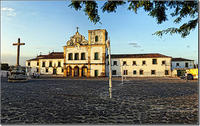You are in: South America -> Brazil -> São Francisco Squar... , and traditional search or Image Gallery will yield results of this site only
São Francisco Square in the Town of São Cristóvão
| Site number: | 1272 |
|
| Type of site: | Cultural | |
| Date: | 18-19 centuries | |
| Date of Inscription: | 2010 | |
| Location: | South America, Brazil, Sergipe, São Cristovão | |
Up to 75 images are shown here. Click on each for more details or on Image Gallery for more images.
| Description: | São Francisco Square is a quadrilateral open space in the town of São Cristovão surrounded by the São Francisco Church and convent, the Church and Santa Casa da Misericórdia, the Provincial Palace, and associated houses from the 18th and 19th centuries. The complex is typical of the Franciscan architecture of northeastern Brazil, and the urban landscape reflects the history of the town since its origin. --WHMNet paraphrase from the description at WHC Site, where additional information is available. | |
| São Cristóvão is a Brazilian city in the Northeastern state of Sergipe. Its population was 75,353 (2005) and its area is 437 km². It is the third largest settlement in the state, behind Aracaju and Nossa Senhora do Socorro. It was established by the Portuguese (in a time when Portugal, Spain and the Naples kingdoms were under the rule of Philip II of Spain) as one of the first colonization attempts in Sergipe, which makes the city the fourth oldest one in Brazil. The development of the town occurred following the Portuguese urban model, that is, in two plans: the higher town, where the headquarters of the civil and religious powers are; and lower town, with the harbour, the factories, and the low income population. It was the state capital until 1855, when the provincial president Inácio Joaquim Barbosa moved the capital to Aracaju. São Francisco Square, in the town of São Cristovão, is a quadrilateral open space surrounded by substantial early buildings such as São Francisco Church and convent, the Church and Santa Casa da Misericórdia, the Provincial Palace and the associated houses of different historical periods surrounding the Square. This monumental ensemble, together with the surrounding 18th- and 19th- century houses, creates an urban landscape which reflects the history of the town since its origin. The Franciscan complex is an example of the typical architecture of the religious order developed in north-eastern Brazil. In 2010 it was selected as a World Heritage Site by UNESCO. --Wikipedia. Text is available under the Creative Commons Attribution-ShareAlike License. | ||
| Source: | http://whc.unesco.org/en/list/1272 | |
| Reference: | 1. UNESCO World Heritage Center (http://whc.unesco.org/en/list/1272). 2. Wikipedia. | |




















